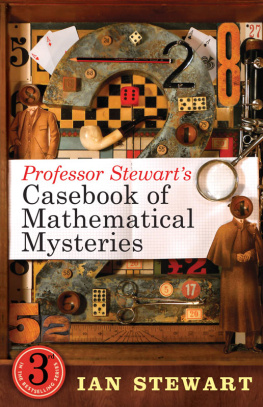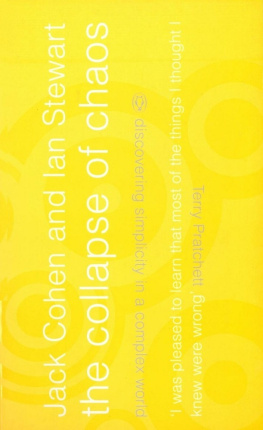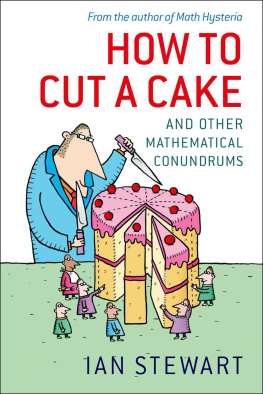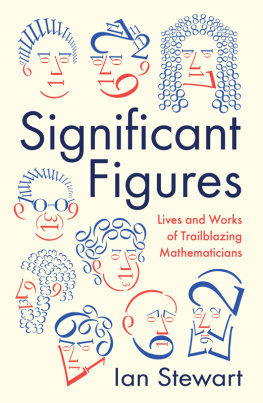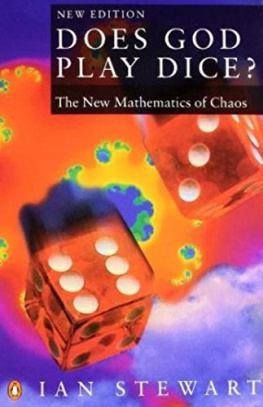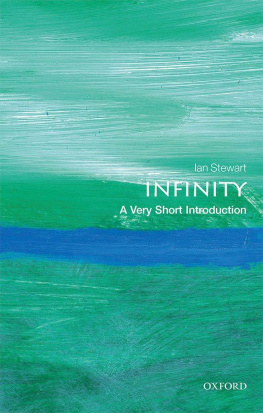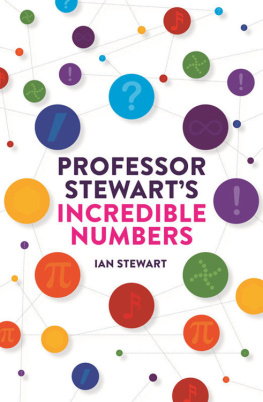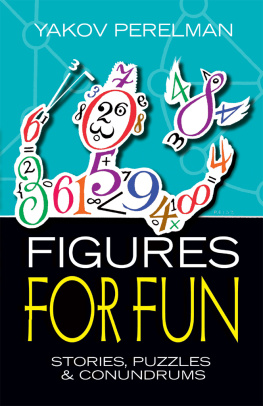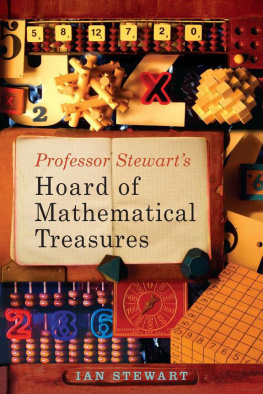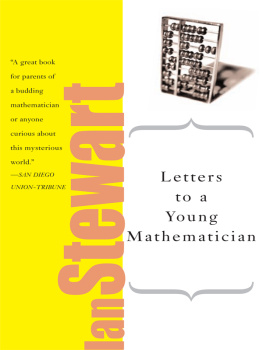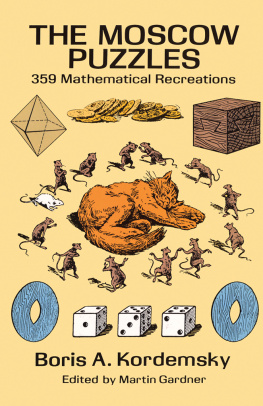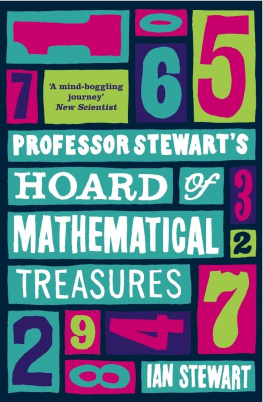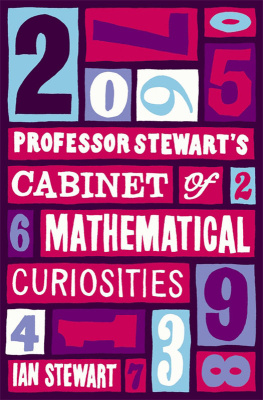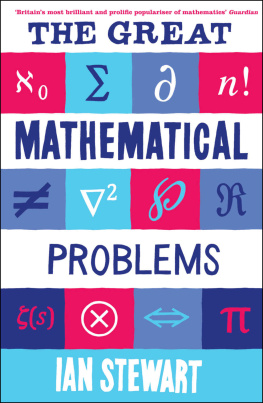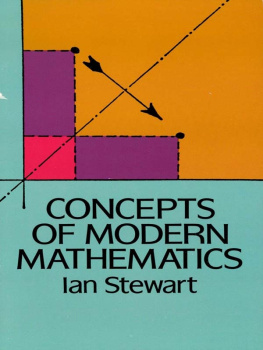Professor Stewarts Casebook of Mathematical Mysteries
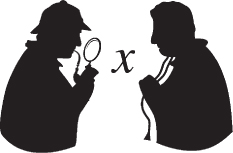
Professor Ian Stewart is known throughout the world for making mathematics popular. He received the Royal Societys Faraday Medal for furthering the public understanding of science in1995, the IMA Gold Medal in 2000, the AAAS Public Understanding of Science and Technology Award in 2001 and the LMS/IMA Zeeman Medal in 2008. He was elected a Fellow of the Royal Society in 2001. He is Emeritus Professor of Mathematics at the University of Warwick, where he divides his time between research into nonlinear dynamics and furthering public awareness of mathematics. His many popular science books include (with Terry Pratchett and Jack Cohen) The Science of Discworld I to IV, The Mathematics of Life, 17 Equations that Changed the World and The Great Mathematical Problems. His app, Professor Stewarts Incredible Numbers, was published jointly by Profile and Touch Press in March 2014.
By the Same Author
Concepts Of Modern Mathematics
Game, Set, And Math
Does God Play Dice?
Another Fine Math Youve Got Me Into
Fearful Symmetry
Natures Numbers
From Here To Infinity
The Magical Maze
Lifes Other Secret
Flatterland
What Shape Is A Snowflake?
The Annotated Flatland
Math Hysteria
The Mayor Of Uglyvilles Dilemma
How To Cut A Cake
Letters To A Young Mathematician
Taming The Infinite (Alternative Title: The Story Of Mathematics)
Why Beauty Is Truth
Cows In The Maze
Mathematics Of Life
Professor Stewarts Cabinet Of Mathematical Curiosities
Professor Stewarts Hoard Of Mathematical Treasures
Seventeen Equations That Changed The World (Alternative Title: In Pursuit Of The Unknown)
The Great Mathematical Problems (Alternative Title: Visions Of Infinity)
Symmetry: A Very Short Introduction Jack Of All Trades (Science Fiction eBook)
with Jack Cohen
The Collapse Of Chaos
Evolving The Alien (Alternative Title: What Does A Martian Look Like?)
Figments Of Reality
Wheelers (Science Fiction)
Heaven (Science Fiction)
The Science Of Discworld Series (With Terry Pratchett & Jack Cohen)
The Science Of Discworld
The Science Of Discworld II: The Globe
The Science Of Discworld III: Darwins Watch
The Science Of Discworld IV: Judgement Day
iPad app
Incredible Numbers
Professor Stewarts Casebook of Mathematical Mysteries
Ian Stewart

First published in 2014 by
PROFILE BOOKS LTD
3A Exmouth House
Pine Street
London EC1R 0JH
www.profilebooks.com
Copyright Joat Enterprises 2014
10 9 8 7 6 5 4 3 2 1
Text design by Sue Lamble
Typeset in Stone Serif by Data Standards Ltd, Frome, Somerset.
The moral right of the author has been asserted.
All rights reserved. Without limiting the rights under copyright reserved above, no part of this publication may be reproduced, stored or introduced into a retrieval system, or transmitted, in any form or by any means (electronic, mechanical, photocopying, recording or otherwise), without the prior written permission of both the copyright owner and the publisher of this book.
A CIP catalogue record for this book is available from the British Library.
eISBN 978 1 84765 432 8
Acknowledgements
Left and centre figures: Laurent Bartholdi and Andr Henriques. Orange peels and Fresnel integrals, Mathematical Intelligencer 34 No. 4 (2012) 13.
Right figure: Luc Devroye.
Box puzzle concept: Moloy De.
Extract from Not a Wake: Mike Keith.
Haiku: Daniel Mathews, Jonathan Alperin, Jonathan Rosenberg.
Amazing squares: devised by Moloy De and Nirmalya Chattopadhyay.
The Thirty-Seven Mystery: based on observations by Stephen Gledhill.
Clueless pseudoku: Gerard Butters, Frederick Henle, James Henle and Colleen McGaughey. Creating clueless puzzles, The Mathematical Intelligencer 33 No. 3 (Fall 2011) 102105.
Right Figure: Steven Snape.
Figure: Courtesy of the UW-Madison Archives.
Left figure: [George Steinmetz, courtesy of Anastasia Photo].
Right figure: NASA, HiRISE on Mars Reconnaissance Orbiter.
Right figure: Rudi Podgornik.
Figure: Veit Schwammle and Hans J. Herrmann. Solitary wave behaviour of sand dunes, Nature 426 (2003) 619620.
Figure: Persi Diaconis, Susan Holmes and Richard Montgomery, Dynamical bias in the coin toss, SIAM Review 49 (2007) 211223.
Figures: Michael Elgersma and Stan Wagon, Closing a Platonic gap, The Mathematical Intelligencer (2014) to appear.
The following figures are reproduced under the Creative Commons Attribution 3.0 Unported license and credited as requested on the description page:
Krishnavedala.
(left) Ricardo Liberato.
Tekisch.
.
Braindrain0000.
LutzL.
Walters Art Museum, Baltimore.
Introducing Soames and Watsup
Professor Stewarts Cabinet of Mathematical Curiosities appeared in 2008, just before Christmas. Readers seemed to like its random mixture of quirky mathematical tricks, games, weird biographies, snippets of strange information, solved and unsolved problems, odd factoids, and the occasional longer and more serious piece on topics such as fractals, topology, and Fermats Last Theorem. So in 2009 it was followed by Professor Stewarts Hoard of Mathematical Treasures, which continued in the same vein with an intermittent pirate theme.
They say that three is a good number for a trilogy. The late Douglas Adams of The Hitchhikers Guide to the Galaxy fame did eventually decide that four was better and five better still, but three sounds like a good place to start. So, after a gap of five years, here is Professor Stewarts Casebook of Mathematical Mysteries. This time, however, theres a new twist. The short quirky items, such as Hexakosioihexekontahexaphobia, the Thrackle Conjecture, What Shape is an Orange Peel?, the RATS Sequence, and Euclids Doodle, are still there. So are more substantial articles about solved and unsolved problems: Pancake Numbers, the Goldbach Conjecture, the Erds Discrepancy Problem, the Square Peg Conjecture, and the ABC Conjecture. So are the jokes, poems, and anecdotes. Not to mention unusual applications of mathematics to flying geese, clumps of mussels, spotty leopards, and bubbles in Guinness. But these miscellanea are now interspersed with a series of narrative episodes featuring a Victorian detective and his medical sidekick
I know what youre thinking. However, I developed the idea a year or so before Benedict Cumberbatch and Martin Freemans spectacularly successful modern take on Sir Arthur Conan Doyles much-loved characters hit the small screen. (Trust me.) More to the point, its not that pair. Not even as portrayed in Sir Arthurs original stories. Yes, my guys live in the original time period, but across the road at number 222B. From there, they cast envious eyes on the stream of rich clients entering the premises of the more famous duo. And from time to time a case comes up that their illustrious neighbours have shunned or failed to solve: such arcane mysteries as the Sign of One, the Dogs that Fight in the Park, the Catflap of Fear, and the Greek Integrator. Then Hemlock Soames and Dr John Watsup put their brains in gear, show their true colours and their strength of character, and triumph over adversity and lack of market presence.
Next page
